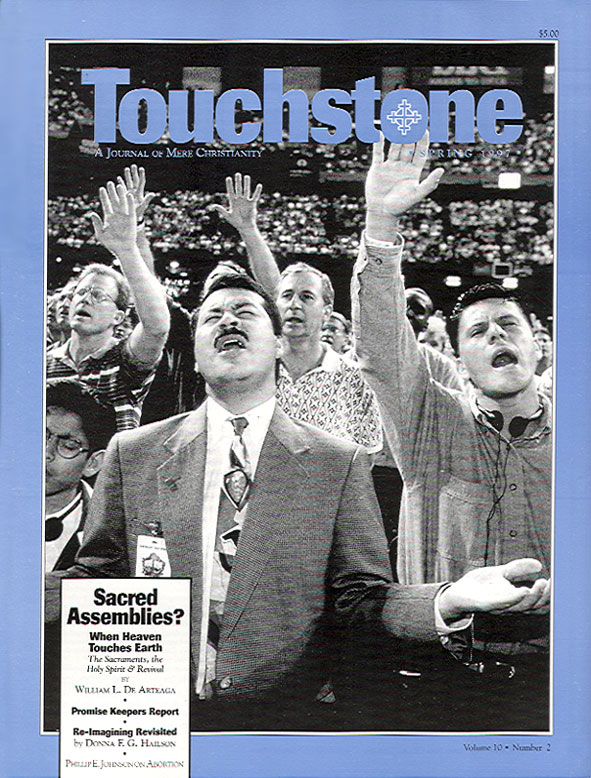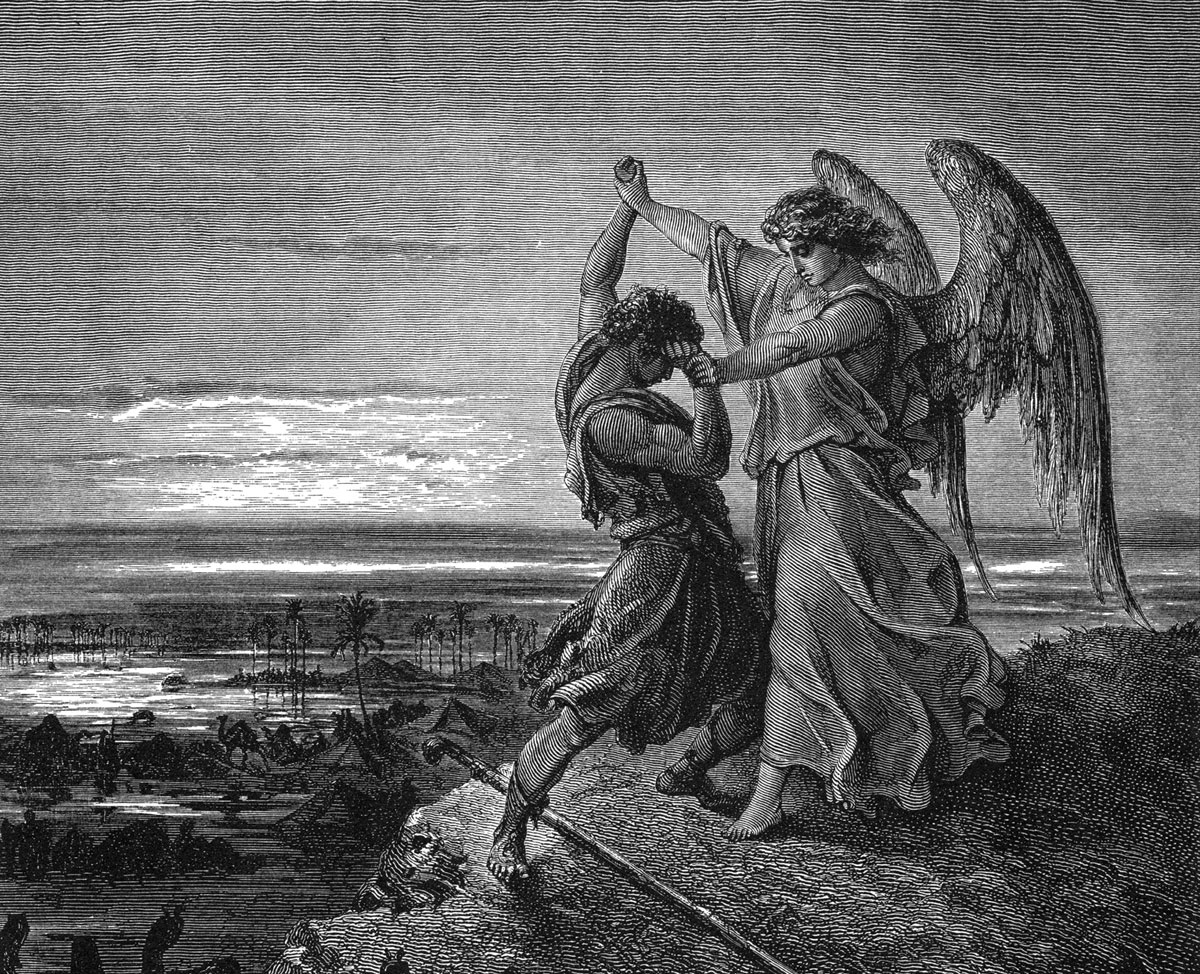Missing Mr. Chesterton
Wisdom & Innocence: A Life of G. K. Chesterton
by Joseph Pearce
San Francisco: Ignatius Press, 1997
(522 pages; $29.95, cloth)
reviewed by Adam Schwartz
Like the character Sunday from his finest novel, The Man Who Was Thursday, G. K. Chesterton (1874–1936) has cast an enigmatic, if imposing, shadow across the landscape occupied by those literary detectives who have attempted to fathom the depths of his life and legacy in the more than sixty years since his death. Chesterton was a prodigious and prolific contributor to every genre, as was C. S. Lewis. Assessing the breadth of the Chesterton corpus is an especially daunting challenge in an era of intellectual fragmentation and specialization. With each new critical work one hopes to find a coherent, integrative framework. Indeed, some respected Chesterton and Lewis scholars have warmly praised Joseph Pearce’s biography of Chesterton; but this volume is finally quite unsatisfactory. Although a competent narrative of Chesterton’s life, it is a superficial account, one largely unconcerned with the intricacies of his thought and marred by significant interpretive shortcomings. As such, it does not advance understanding of Chesterton’s beliefs nor help to resolve disputed claims concerning his convictions and their consequences.
It may seem odd to characterize a book of over 500 pages as superficial, but the volume’s lack of depth can be seen in both Pearce’s research and writing. Although Wisdom and Innocence claims to draw upon much previously unpublished material, this data actually only makes up a small portion of biographical source material. This work, while basically useful, merely confirms and enriches previous impressions of Chesterton rather than opening new avenues of analysis. Moreover, there remains a significant amount of unpublished material (held currently in the British Library’s Chesterton Archive) that Pearce appears not to have consulted. More troubling, however, is his lack of engagement with most of the scholarly criticism done on Chesterton. Pearce has read previous biographies carefully, and is willing to take issue with them, such as when he justly chides Alzina Stone Dale for misunderstanding the nature of Chesterton’s Catholicism and its centrality to his worldview (485). But Pearce gives no evidence of having studied the more specific scholarship on Chesterton’s thought and writing; indeed his analysis seems entirely ignorant of the incisive contributions made by the likes of Garry Wills, John Coates, and Ian Boyd. Examination of such sources would have added necessary nuance and texture to his renditions of Chesterton’s writings.
Even the structure adopted by Pearce contributes to this shallowness. He follows a strictly chronological approach to the events in Chesterton’s life. This is useful in one respect but hinders the consideration of major themes and issues and leads to redundant citations of events and evidence. Additionally, Pearce’s usual method of dealing with an incident or idea is to identify it and then supply a lengthy, but unanalyzed, quotation. In addition to sacrificing depth for breadth in the process, Pearce also often chooses details and citations that hardly warrant extensive treatment or direct quotation. Such a procedure is especially tempting when dealing with the most quoted writer in the English language, but Pearce’s editors should have limited the use of this technique.
Yet this desire to let Chesterton “speak for himself” is indicative of a more serious flaw in Pearce’s approach: his lack of interest in Chesterton as a thinker. More than most intellectuals, Chesterton lived the life of the mind to the exclusion of practical concerns, and contended that a person’s view of the universe is the most important thing that can be known about him or her. Moreover, eminent peers such as Ronald Knox and Etienne Gilson rightly dubbed him one of the deepest thinkers of their time. Pearce is aware of such testimonials; indeed, one of the best features of his book is his tracing of the widespread influence Chesterton had, from the more predictable and well-known cases of C. S. Lewis and Dorothy Sayers to those of nationalist politicians like Gandhi and Michael Collins, even to cinematic giants like Alec Guiness and Alfred Hitchcock. Taken alone, however, Pearce’s account does not adequately demonstrate why Chesterton’s ideas are of such broad and lasting interest.
For instance, Pearce devotes an entire chapter to Chesterton’s relationships with children, but spends less than five pages discussing his finest book, The Everlasting Man. Yet brevity here is not the soul of wit. Although Pearce admires this volume, he clearly has not grasped the Chestertonian theology of history that so impressed C. S. Lewis: the notion that history is not an evolutionary progression but a series of qualitative irruptions culminating in Christ and the Church. Although Pearce presents The Everlasting Man correctly as anti-progressive, the theological—and specifically Catholic Christian—alternative Chesterton advances is barely sketched. Pearce’s preference for anecdote rather than analysis serves him well in assessing Chesterton’s relationships, especially with Bernard Shaw, and in painting evocative portraits of certain events, such as his last days and death. Ultimately, however, this method fails to emphasize the ideas that Chesterton himself considered to be the most important and that account for his enduring appeal.
This lack of analysis creates other interpretive problems. In so far as Pearce has a thesis, it is given in his title, that “to Chesterton innocence is the beginning of wisdom” (147). Pearce believes that this was “the foundation of his whole philosophy” (285). While accurate in broad terms, Pearce’s conception of Chestertonian “innocence” needs significant qualification. Pearce claims that it was not until after 1911 that Chesterton’s innocence was “tempered by pain and bitter experience” (176). Such a view, however, severely underestimates the trauma Chesterton suffered during an adolescent breakdown while a student at the Slade School of Art in the early 1890s. Chesterton referred to this time as “my period of madness,” and his concerns for his sanity were echoed by his friends. When the shallow progressivism he had inherited from his parents was challenged by fashionable fin-de-siècle decadence and pessimism, Chesterton simply could not come up with an adequate response. Confronted with this dilemma, he sought a new integrating principle for his beliefs, but the alternatives he explored all moved him away from external realities and deeper within the valley of his restless mind. For a time, Chesterton succumbed to an idealistic form of solipsism—the belief that only the self can be proven to exist—and his mind began to break under the pressure of thinking itself the center and author of being. By reading authors who affirmed the basic goodness and objectivity of being (particularly Browning, Stevenson, and Whitman), however, Chesterton emerged from these depths by the late 1890s and began to formulate his core principles: gratitude for the elementary fact of existence, and a corresponding sense of childlike wonder at every form of being. From that point on, these two insights drove Chesterton’s intellectual and spiritual development, ultimately leading him to Thomistic Catholicism.
Like most Chesterton scholars, Pearce underestimates the importance of this pivotal episode. The six pages devoted to it fail to analyze its dynamics and the way it formed the continuous undercurrent of Chesterton’s subsequent convictions and writings. Pearce does not refer to these issues in his discussions of Chesterton’s books on Browning and Stevenson, and he also mistakenly claims that Chesterton experienced “the comfort of complacency—or the complacency of comfort” (176) before the mid-1910s. In fact, Chesterton had warned against this affliction of comfort by at least 1902, and again in 1908 in The Man Who Was Thursday, a novel that Chesterton himself described as an allegory of his Slade breakdown and recovery. For Pearce, however, Thursday is all “contradiction and conundrum” (107), since he has failed to recognize the book’s proper setting. More broadly, a careful reading of the Chesterton corpus—whether it was his lifelong condemnations of anything that smacked of idealism and pessimism, his constant reiterations of the “primeval duty of Praise,” or his consistent employment of “sanity” as his characteristic metaphor—reveals that Garry Wills was correct to conclude over three decades ago that
we shall see the marks of this period on everything he wrote and find that the influence is of the sort he describes, involving an intellectual struggle between realism and solipsism. Only in this context can we understand his later comments on Impressionism, Whitman, Stevenson, lunacy, childhood, and many other things.1
In short, Chesterton’s wise innocence was part of his mental makeup from his earliest days as an author and to ignore how it emerged from his adolescent struggles is fundamentally to misunderstand the character of Chesterton’s life and thought.
Adam Schwartz is Assistant Professor of History at Christendom College.
subscription options
Order
Print/Online Subscription

Get six issues (one year) of Touchstone PLUS full online access including pdf downloads for only $39.95. That's only $3.34 per month!
Order
Online Only
Subscription

Get a one-year full-access subscription to the Touchstone online archives for only $19.95. That's only $1.66 per month!
bulk subscriptions
Order Touchstone subscriptions in bulk and save $10 per sub! Each subscription includes 6 issues of Touchstone plus full online access to touchstonemag.com—including archives, videos, and pdf downloads of recent issues for only $29.95 each! Great for churches or study groups.
Transactions will be processed on a secure server.
more from the online archives
calling all readers
Please Donate
"There are magazines worth reading but few worth saving . . . Touchstone is just such a magazine."
—Alice von Hildebrand
"Here we do not concede one square millimeter of territory to falsehood, folly, contemporary sentimentality, or fashion. We speak the truth, and let God be our judge. . . . Touchstone is the one committedly Christian conservative journal."
—Anthony Esolen, Touchstone senior editor










